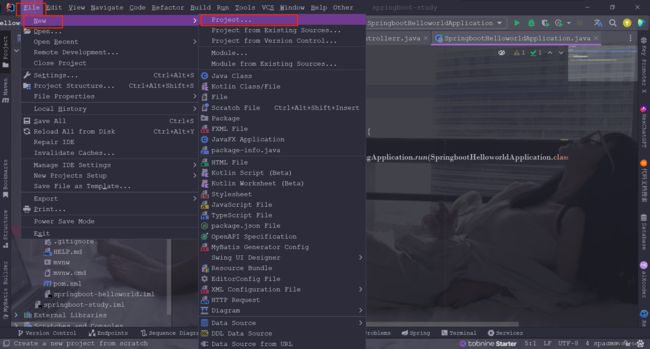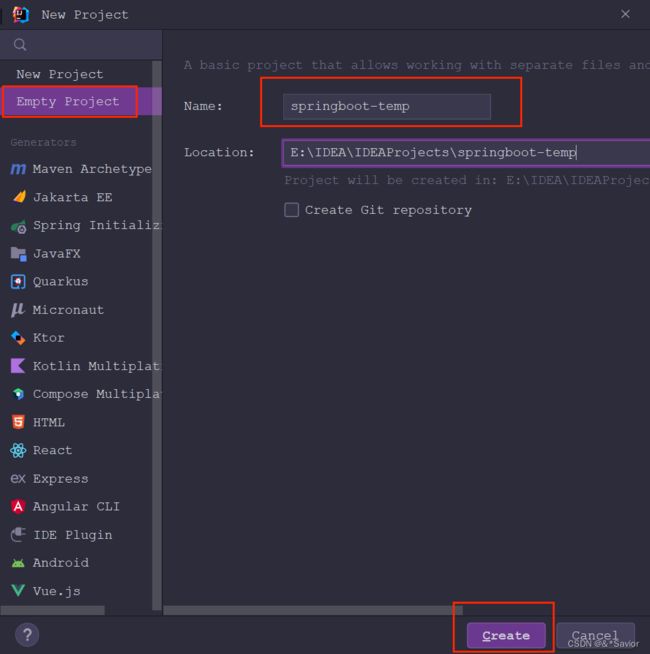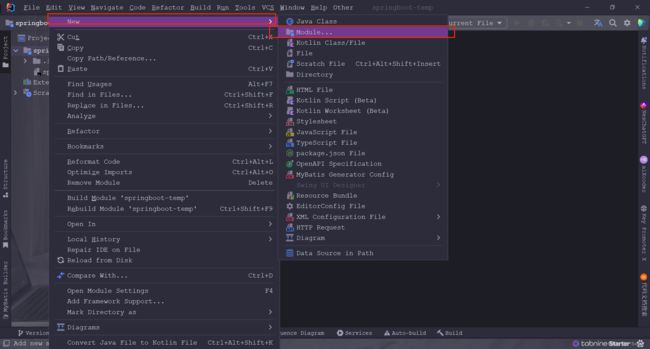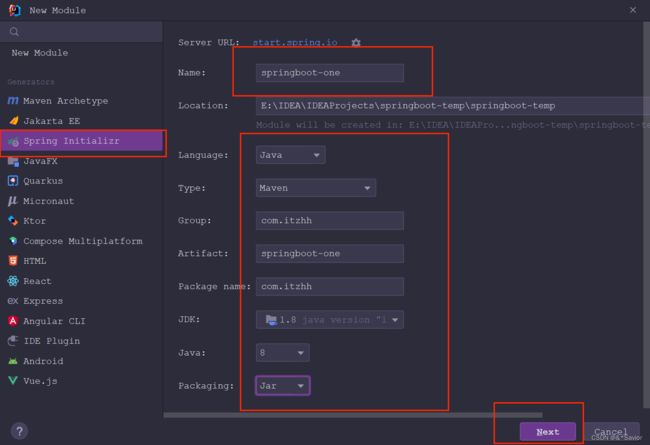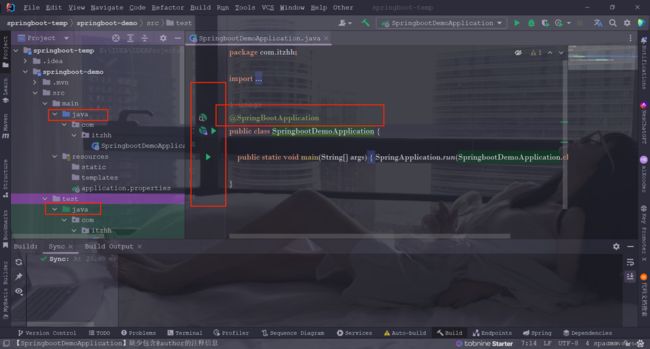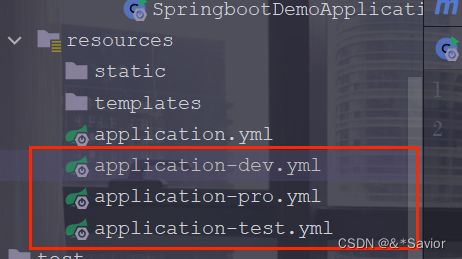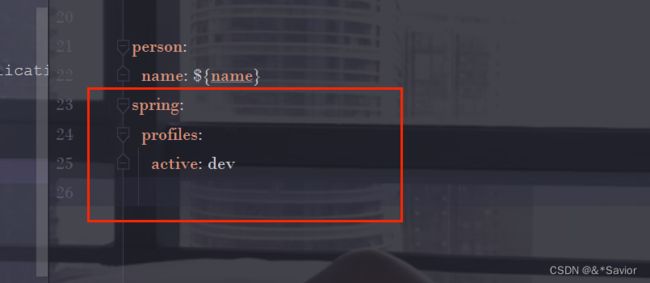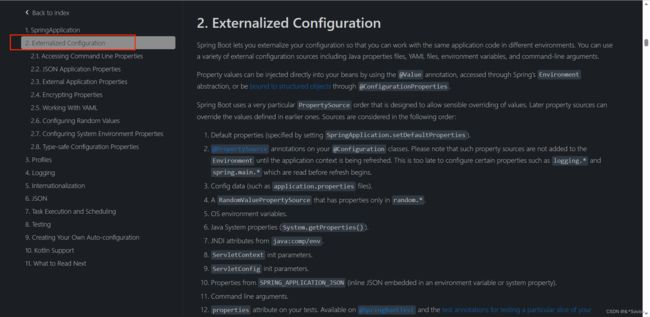SpringBoot
SpringBoot
SpringBoot简介
-
SpringBoot提供了一种快速使用Spring的方式,基于约定优于配置的思想,可以让开发人员不必在配置和逻辑业务之间进行思维的切换,全身心的投入到逻辑代码的编写中,从而大大提高了开发的效率。
-
SpringBoot的自动配置是在应用程序启动时,考虑众多因素,才决定Spring配置应该用哪个,该过程是SpringBoot自动完成的。
-
SpringBoot提供了一种快速开发Spring项目的方式,而不是对Spring功能上的增强。
-
Spring的缺点:
配置繁琐
依赖繁琐 -
SpringBoot功能:
自动配置
起步依赖:依赖传递
辅助功能 -
个人看法:
在实际写代码的过程中,逻辑层代码(三层结构的代码)和SSM框架没有变化。但是SpringBoot创建的时候方便了很多,而且内置的Tomcat等容器,不再需要我们单独配置。依赖的管理也让我们在创建项目后减少了不必要的版本冲突。
创建一个简单的SpringBoot项目
- 选择依赖和springboot版本,这边的依赖不选后面也可以直接通过在pom.xml中添加依赖实现, 只是这样方便一点。
-
导致这个问题的原因是版本的问题,Maven和springboot的版本不匹配,这个就根据自己的情况可以去查一下自己的Maven版本支持什么范围的springboot,或者你想用的springboot版本支持哪些版本的Maven。
-
这边创建成功后做一个小测试,看能否正常呈现。
-
创建controller,编写测试demo1。注意一定要和启动类在同一级目录下, 不然没用。
-
点击启动类启动,出现spring图形,默认端口为8080,可以通过浏览器访问,看结果。
SpringBoot配置
SpringBoot配置文件分类
-
SpringBoot是基于约定的,所以很多配置都有默认值,比如前面所提到的端口默认为8080,如果想使用自己的配置替换默认配置的话,就可以使用application配置文件进行配置。
-
有三种后缀:properties、yml、yaml。
-
application.properties中
server.port=8080
- application.yml和application.yaml中,注意,:后面有一个空格,这个不能少
server:
port: 8080
- 配置文件名称:application
- 在同一级目录下优先级:properties>yml>yaml
yaml介绍
- YAML全称是 YAML Ain’t Markup Language 。YAML是一种直观的能够被电脑识别的的数据数据序列化格式,并且容易被人类阅读,容易和脚本语言交互的,可以被支持YAML库的不同的编程语言程序导入,比如: C/C++, Ruby, Python, Java, Perl, C#, PHP等。YML文件是以数据为核心的,比传统的xml方式更加简洁。YAML文件的扩展名可以使用.yml或者.yaml。
yaml基本语法
- 大小写敏感
- 数据值前边必须有空格,作为分隔符
- 使用缩进表示层级关系
- 缩进时不允许使用Tab键,只允许使用空格
- 缩进的空格数目不重要,只要相同层级的元素左侧对齐即可
- #表示注释,从这个字符一直到行尾,都会被解析器忽略
yaml数据格式:
- 对象(map):键值对的集合
person:
name: zhangsan
# 行内写法
person: {name: zhangsan}
- 数组:一组按次序排列的值
address:
- beijing
- shanghai
# 行内写法
address: [beijing,shanghai]
- 纯量:单个的、不可再分的值
msg1: 'hello \n world' # 单引忽略转义字符
msg2: "hello \n world" # 双引识别转义字符
- 参数引用
name: lisi
person:
name: ${name} # 引用上边定义的name值
读取配置文件内容
先在yml中定义一些用于测试的数据
address:
- beijing
- shanghai
- tianjin
# 行内写法
#address: [beijing,shanghai]
msg1: 'hello \n world' # 单引忽略转义字符
msg2: "hello \n world" # 双引识别转义字符
name: wangwu
person:
name: ${name}
@Value
- 这种写法需要一个个创建对象,数据较少可以,数据较多时很显然会很麻烦。
package com.itzhh.controller;
import org.springframework.beans.factory.annotation.Value;
import org.springframework.web.bind.annotation.RequestMapping;
import org.springframework.web.bind.annotation.RestController;
/**
* @author: zhh
* @date: 2023-04-16 18:35
* @description: <描述>
*/
@RestController
public class DemoController {
@Value("${name}")
private String name;
@Value("${address[1]}")
private String address;
@Value("${person.name}")
private String name2;
@Value("${msg1}")
private String msg1;
@Value("${msg2}")
private String msg2;
@RequestMapping("/demo2")
public String demo2() {
System.out.println("name="+name);
System.out.println("name2="+name2);
System.out.println("msg1="+msg1);
System.out.println("msg1="+msg2);
System.out.println("address="+address);
return "demo2";
}
}
Environment
创建一个Environment对象,然后通过这个对象来获取。
package com.itzhh.controller;
import org.springframework.beans.factory.annotation.Autowired;
import org.springframework.beans.factory.annotation.Value;
import org.springframework.core.env.Environment;
import org.springframework.web.bind.annotation.RequestMapping;
import org.springframework.web.bind.annotation.RestController;
/**
* @author: zhh
* @date: 2023-04-16 18:35
* @description: <描述>
*/
@RestController
public class DemoController {
@Autowired
private Environment environment;
@RequestMapping("/demo3")
public String demo3() {
System.out.println(environment.getProperty("name"));
System.out.println(environment.getProperty("person.name"));
System.out.println(environment.getProperty("msg1"));
System.out.println(environment.getProperty("msg2"));
System.out.println(environment.getProperty("address[1]"));
return "demo3";
}
}
@ConfigurationProperties
先写一个类,加上这个注解
package com.itzhh.entity;
import org.springframework.boot.context.properties.ConfigurationProperties;
import org.springframework.stereotype.Component;
import java.util.Arrays;
/**
* @author: zhh
* @date: 2023-04-16 20:05
* @description: <描述>
*/
@Component
@ConfigurationProperties
public class ConfigEntity {
private String name;
private String[] address;
public ConfigEntity() {
}
public ConfigEntity(String name, String[] address) {
this.name = name;
this.address = address;
}
public String getName() {
return name;
}
public void setName(String name) {
this.name = name;
}
public String[] getAddress() {
return address;
}
public void setAddress(String[] address) {
this.address = address;
}
@Override
public String toString() {
return "ConfigEntity{" +
"name='" + name + '\'' +
", address=" + Arrays.toString(address) +
'}';
}
}
写这个注解会出现红色的提示,不影响,但是不好看,可以去掉

点进去,将其中的依赖加上。
<dependency>
<groupId>org.springframework.bootgroupId>
<artifactId>spring-boot-configuration-processorartifactId>
<optional>trueoptional>
dependency>
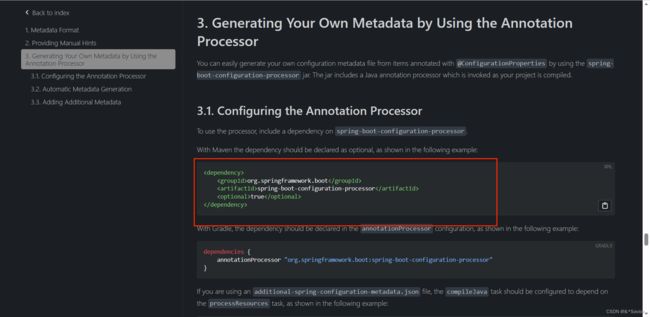
此时,再回去看时就没有了。
在controller中创建这个对象,即可获取其中的数据。
package com.itzhh.controller;
import com.itzhh.entity.ConfigEntity;
import org.springframework.beans.factory.annotation.Autowired;
import org.springframework.beans.factory.annotation.Value;
import org.springframework.core.env.Environment;
import org.springframework.web.bind.annotation.RequestMapping;
import org.springframework.web.bind.annotation.RestController;
import java.util.Arrays;
/**
* @author: zhh
* @date: 2023-04-16 18:35
* @description: <描述>
*/
@RestController
public class DemoController {
@Autowired
private ConfigEntity configEntity;
@RequestMapping("/demo4")
public String demo4() {
System.out.println(configEntity.getName());
Arrays.asList(configEntity.getAddress()).stream()
.forEach(System.out::println);
return "demo4";
}
}
profile
我们在开发Spring Boot应用时,通常同一套程序会被安装到不同环境,比如:开发、测试、生产等。其中数据库地址、服务器端口等等配置都不同,如果每次打包时,都要修改配置文件,那么非常麻烦。profile功能就是来进行动态配置切换的。
profile配置方式
多profile文件方式
- application-dev.properties/yml 开发环境
- application-test.properties/yml 测试环境
- application-pro.properties/yml 生产环境
yml多文档方式
- 在yml中使用 — 分隔不同配置
---
server:
port: 8081
spring:
profiles: dev
---
server:
port: 8082
spring:
profiles: test
---
server:
port: 8083
spring:
profiles: pro
---
spring:
profiles:
active: dev
profile激活方式
-
虚拟机参数:在VM options 指定:
-Dspring.profiles.active=dev
内部配置加载顺序
Springboot程序启动时,会从以下位置加载配置文件:
- file:./config/:当前项目下的/config目录下
- file:./ :当前项目的根目录
- classpath:/config/:classpath的/config目录
- classpath:/ :classpath的根目录
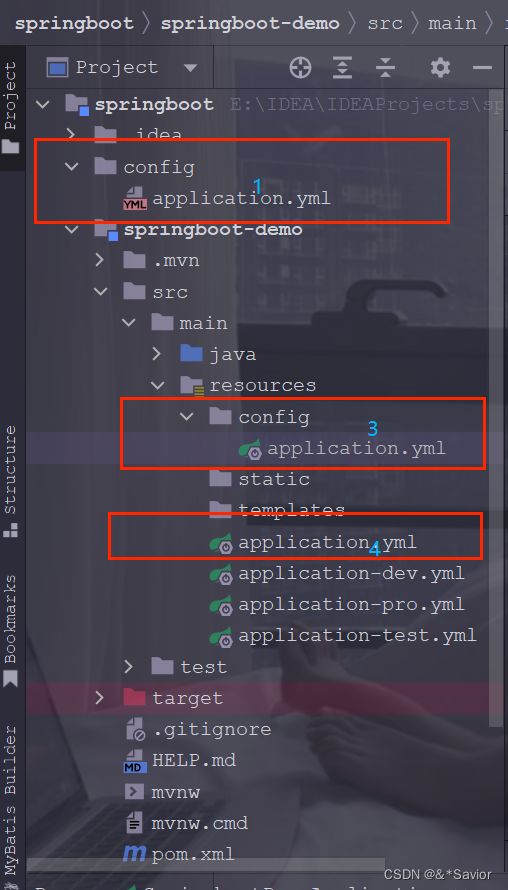
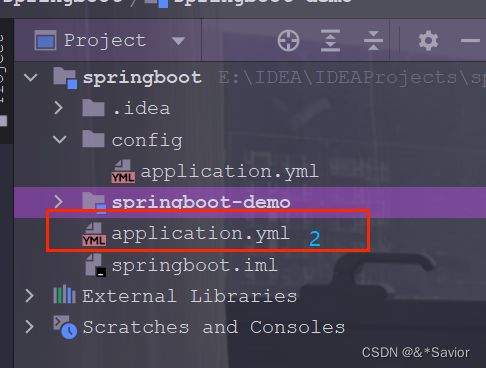
加载顺序为上文的排列顺序,高优先级配置的属性会生效
外部配置加载顺序
整合其它框架
整合Junit
- 一般测试内容为service代码,所以先编写一段用来测试
- 接着加入相关依赖,并写测试类。主要两个注解
@RunWith(SpringRunner.class) @SpringBootTest(classes = SpringbootDemoApplication.class)
package com.itzhh;
import com.itzhh.service.DemoService;
import org.junit.Test;
import org.junit.runner.RunWith;
import org.springframework.beans.factory.annotation.Autowired;
import org.springframework.boot.test.context.SpringBootTest;
import org.springframework.test.context.junit4.SpringRunner;
/**
* @author: zhh
* @date: 2023-04-16 22:03
* @description: <描述>
*/
@RunWith(SpringRunner.class)
@SpringBootTest(classes = SpringbootDemoApplication.class)
public class DemoServiceTest {
@Autowired
private DemoService demoService;
@Test
public void test(){
demoService.test1();
}
}
整合mybatis
主要加上相关依赖和配置datasource,这个我之前在mybatis-plus中有,都差不多,这边不记录了。具体可以看mybatis-plus1
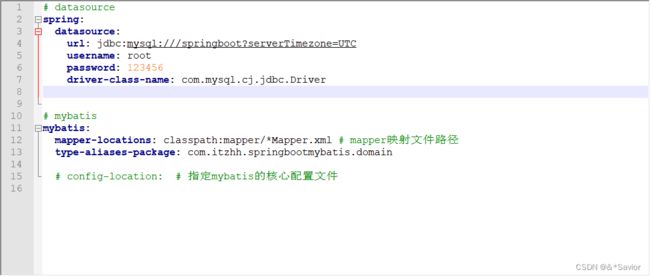
依赖主要有:
<dependencies>
<dependency>
<groupId>org.mybatis.spring.bootgroupId>
<artifactId>mybatis-spring-boot-starterartifactId>
<version>2.1.0version>
dependency>
<dependency>
<groupId>mysqlgroupId>
<artifactId>mysql-connector-javaartifactId>
dependency>
<dependency>
<groupId>org.springframework.bootgroupId>
<artifactId>spring-boot-starter-testartifactId>
<scope>testscope>
dependency>
dependencies>
整合Redis
主要依赖:
<dependency>
<groupId>org.springframework.bootgroupId>
<artifactId>spring-boot-starter-data-redisartifactId>
dependency>
<dependency>
<groupId>org.springframework.bootgroupId>
<artifactId>spring-boot-starter-testartifactId>
<scope>testscope>
dependency>
<dependency>
<groupId>junitgroupId>
<artifactId>junitartifactId>
<scope>testscope>
dependency>
dependencies>
application.yml 由于是本机安装的redis环境,这边这个可以不配置,都是默认值
spring:
redis:
host: 127.0.0.1 # redis的主机ip
port: 6379
双击启动,附redis,直接下载解压即可。
链接:https://pan.baidu.com/s/1CdyZvRnb_46lH9DSPJWHyA 提取码:1111
package com.itzhh;
import org.junit.jupiter.api.Test;
import org.junit.runner.RunWith;
import org.springframework.beans.factory.annotation.Autowired;
import org.springframework.boot.test.context.SpringBootTest;
import org.springframework.data.redis.core.RedisTemplate;
import org.springframework.test.context.junit4.SpringRunner;
@RunWith(SpringRunner.class)
@SpringBootTest
class SpringbootRedisApplicationTests {
@Autowired
private RedisTemplate redisTemplate;
@Test
public void testSet() {
//存入数据
redisTemplate.boundValueOps("name").set("zhangsan");
}
@Test
public void testGet() {
//获取数据
Object name = redisTemplate.boundValueOps("name").get();
System.out.println(name);
}
}
小结与彩蛋
上面所写基本上算是一个springboot的小入门,有了SSM的基础,再结合我上面所写,基本上也能够实现一个完整的springboot的项目,不过,springboot在版本这方面需要考虑周全,包括IDEA、Maven、SpringBoot的版本需要合适才行,不然会有很多问题。
另外,这边给个彩蛋。每次启动springboot的项目都会有一个spring的图像,这个是可以改的,在resources下添加一个banner.txt,将需要展示的图像写在其中重新启动即可。这个给一个可以生成图像的网址:banner生成器
添加完后就可以像下面这样了。

